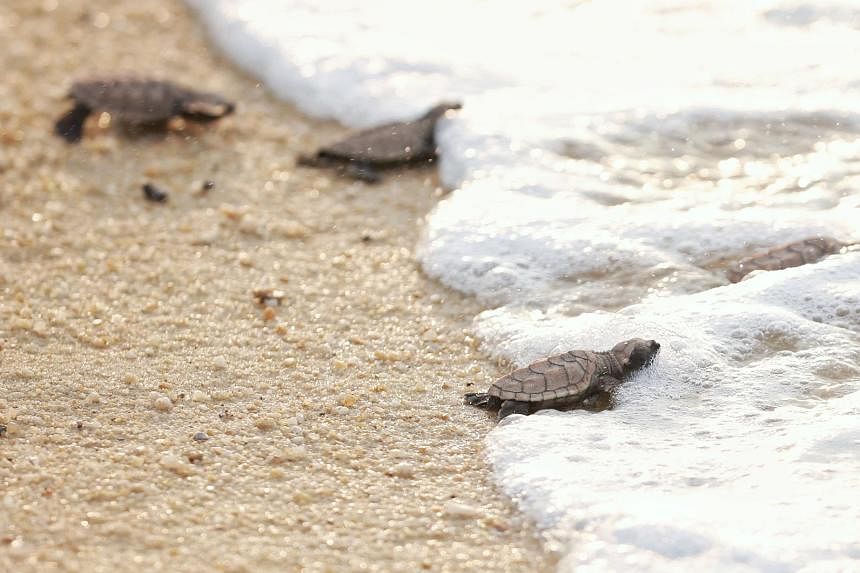SINGAPORE - Secrets uncovered from the DNA of hawksbill turtles could succeed, for the first time, in tracking exactly where they go to nest and forage.
The DNA study may even reveal what happens during “the lost years” when baby turtles roam the open seas and disappear from human scrutiny.
Researchers from the Singapore Centre for Environmental Life Sciences Engineering (SCELSE) and the Asian School of the Environment (ASE) at the Nanyang Technological University (NTU), who are involved in this effort, say that DNA analysis bypasses the limitations of current work, which relies on satellite trackers strapped to the critically endangered creatures.
ASE’s Assistant Professor Kim Hie Lim, 42, said the limitations of using satellite trackers strapped to the back of the turtles include the battery life, attachment and antenna failure, salt water erosion and death of the turtle.
“It is very important, as scientists, to understand where they go to lay their eggs, where they forage and where they stay during their juvenile years, and genetic samples are much easier to access to produce more precise data.
“There are many missing pieces (to this story) and it is here that genetics play a very important role,” she said.
“Here, we can collect genetic samples easily to produce more data than satellite tracking to allow broader understanding of where the turtles go across countries and across regions, but at the end, we still combine data from both methods to improve the resolution of the research.”
It had been proven in overseas studies of other species of sea turtles that hidden in a hatchling’s DNA is its entire family history, and it is through this DNA fingerprinting that many elusive questions can be answered.
Dr Kim, who is also the principal investigator from the Meta-’omics and Microbiomes cluster of SCELSE, and her team are doing just that to unlock that key to the secrets of the critically endangered hawksbill turtle.
They have sequenced DNA of 700 based pairs by using DNA that is passed from mother to offspring and are aiming to piece together the first complete hawksbill turtle’s genome, which has about two billion base pairs.
Both Dr Kim and PhD student Regine Tiong, 26, have been sequencing the genome using eggshells, unhatched eggs and soil around the nests since 2018, and this is being done in partnership with the National Parks Board (NParks).
“Many researchers in other regions are also looking at the DNA passed down from the mothers and from there, we are able to work together to find out where they forage or where they nest,” said Dr Kim.
“We can already see what kinds of lineage are coming into Singapore, and discovering individual genetic differences between hawksbill turtles will provide more data on the types of genetic relationships Singaporean hawksbill turtles have with other international populations.”
According to the World Wide Fund for Nature (WWF), hawksbill turtles declined globally by over 80 per cent in the last century.
There are difficulties in accurately assessing population size, but it has been estimated that there are more than 8,000 nesting females worldwide. There are only five populations globally, with more than 1,000 females nesting annually.
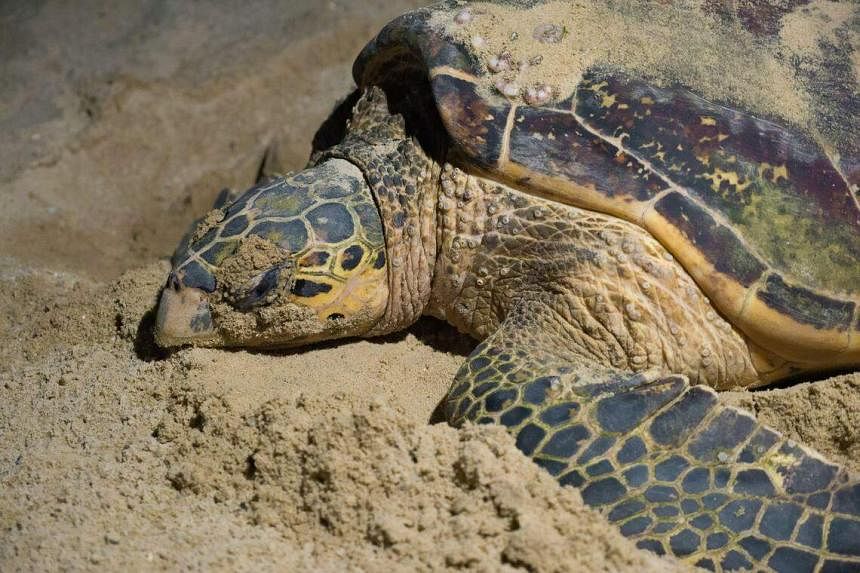
The recent 120 hatchlings that emerged from a nest at the East Coast Park beach on July 17 spelled hope for the species.
“We had a 92 per cent hatch rate and that is great, considering the many challenges the mother turtle faced, including the fact that she had to dig through grass and sand; and that there were so many people around,” said Ms Tiong, who had returned to the site on Friday morning to collect the 10 unhatched eggs, the 120 eggshells and soil around the nest to draw DNA from.
“It is pretty good to see this successful nest and to know that there are many hatchlings that are returning to the sea. This increases the possibility of them reaching adulthood and continuing this life cycle for many generations to come. As for the 10 that did not hatch, they are opportunities for SCELSE’s genetics research,” she added.
With the population of hawksbill turtles having declined by 80 per cent over the past 120 years, researchers worldwide take the opportunity to collect samples to study when their nests are found.
The conservation and population recovery of hawksbill turtles in Singapore are highly dependent on management actions, such as nest relocation and habitat protection, and a better understanding of how these turtles use and move between distinct habitats.
As hawksbill turtles are exploited for their beautiful shells, making them extremely vulnerable in the illegal global trade of tortoiseshell products, some regions have turned to obtaining mitochondrial DNA from these products to trace the sample back to a likely stock origin.
The scientists here are looking to work with their counterparts from Malaysia, Indonesia and the Philippines to understand the population that nests and forages in South-east Asia, and ultimately, how best to protect them.
“If we are able to have the whole genome sequencing data of the hawksbill turtle genome or that of many individual turtles or even the many populations, it would be very powerful data for the understanding of this species and how climate change can have its effect on this species,” Dr Kim said.
Hot girls and cool dudes
Population sampling is essential in assessing species richness of an ecosystem. A sample of 20 from the 120 hawksbill hatchlings that emerged from a nest about 40cm deep at East Coast Park on July 17 was measured for data gathering of a nesting population.
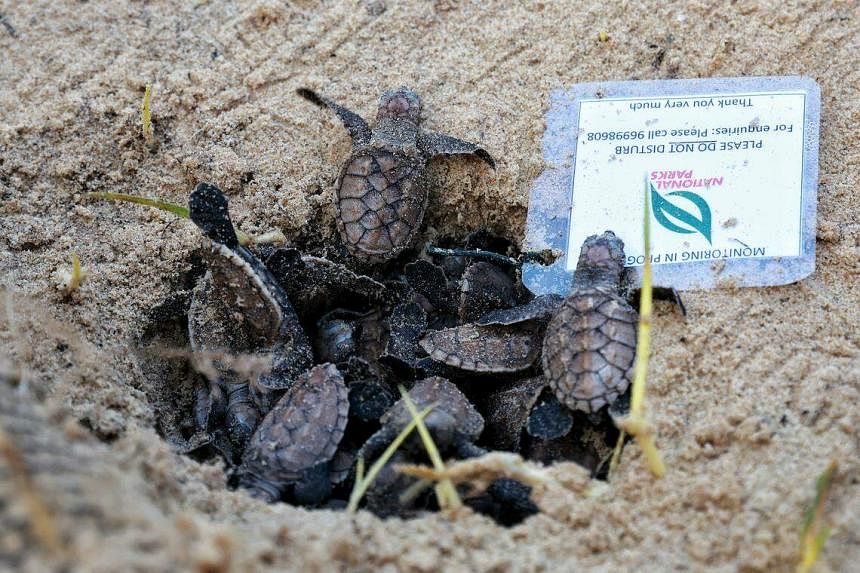
National Parks Board (NParks) deputy director of the coastal and marine branch Collin Tong said: “Typically, a nesting hawksbill lays more than 100 eggs in each nest. The eggs incubate for about 55 days and the hatchlings emerge in two batches.”
The influence of temperature on the sex of hatchling sea turtles has been documented, and the sex ratio among hatchlings produced at a nesting beach varies both seasonally and annually.
“The pivotal temperature is 28.5 deg C. Among us conservationists, we say ‘girls are hot, and dudes are cool’,” he added. According to the US’ National Oceanic and Atmospheric Administration (NOAA), if the eggs incubate at about 27.7 deg C, the hatchlings will be male, and at about 31 deg C, they will be female.
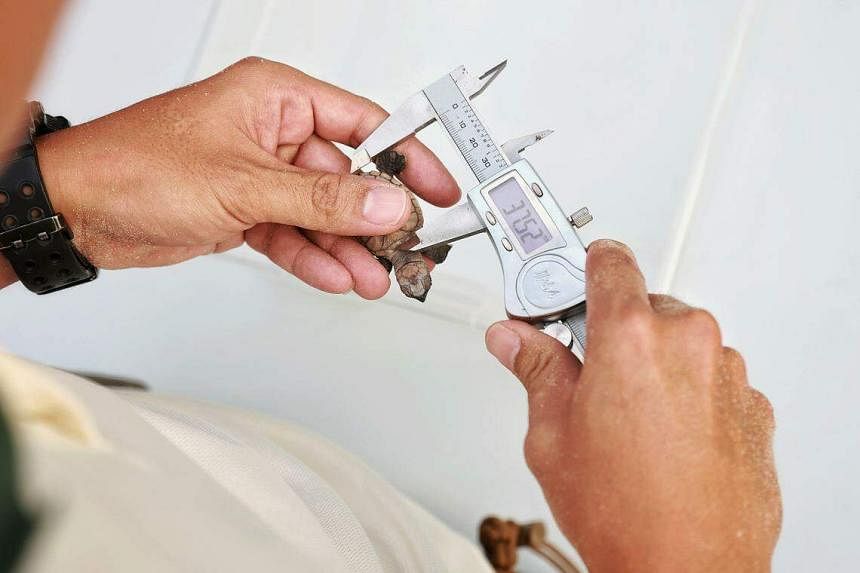
NParks conservation officers take measurements of the sample of hatchlings to determine the health status of those emerging from a particular nest. Hawksbill hatchlings are light to dark brown and are relatively small, with a typical shell length of about 37mm.
“If the shell of a hatchling is 30mm or less, then either its genes are weak or the incubation period is not conducive for the eggs. As such, their survival may be compromised,” Mr Tong said.
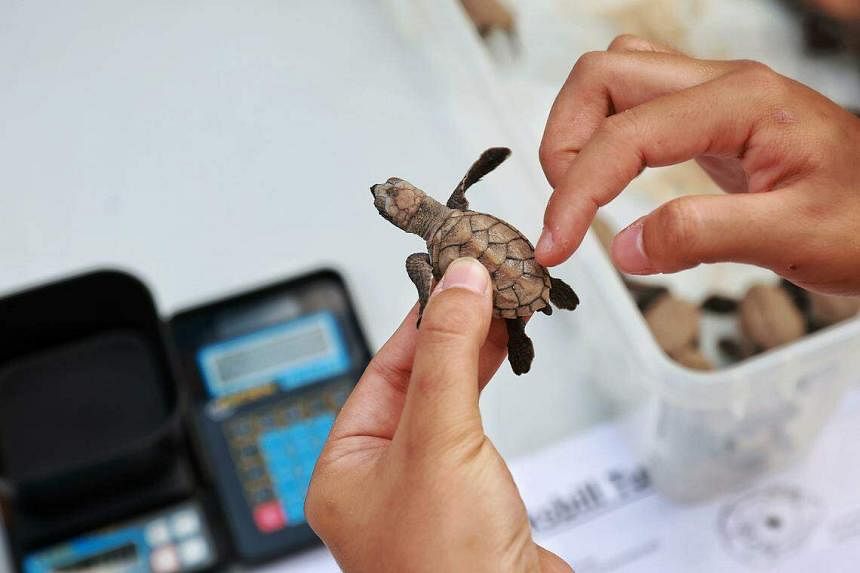
To ensure that the hawksbill hatchlings are healthy, conservation officers at NParks examine and count the scales on the head, behind the eyes and the number and arrangement of the plates, or scutes, on the top and the bottom shells, “much like doctors checking to see if a newborn has all his 10 fingers and 10 toes”, Mr Tong explained.
The shell of the hawksbill turtle is unique, as the scutes overlap. When examining a hatchling, the officers look at the primary scutes, which comprise the marginals, laterals, vertebrals (in the centre of the top shell) and nuchals, which are directly behind the turtle’s head. The scute pattern on the underside of the hatchling is also examined.
Ms Regine Tiong, a PhD student at SCELSE’s Population Genetics and Wildlife Conservation, and NParks conservation officer Jerome Yong, collected the eggshells, unhatched eggs and soil around the nest on Friday after 120 hawksbill turtles successfully emerged and made their way to the sea on July 17.
Ms Tiong will extract samples of the hawksbill turtle DNA from the yolk of the unhatched eggs, eggshells and liver samples from any stillborn hatchlings for sequencing, in a bid to ensure that the species thrive. The data collected will also help provide information on the fast-disappearing species of sea turtles.
